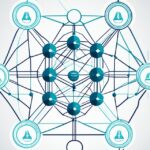Table of Contents
Airdrop following a hard fork means giving new tokens to users after a blockchain split1.
When a virtual currency’s code changes, a hard fork occurs. This creates new and original blockchains. Airdrop gives new tokens to the holders of the old cryptocurrency.
If you have Bitcoin or Ethereum, you get new tokens the same amount as what you own now1.
Airdrops may come with ICOs or be free for some investors. If people sell these tokens, the new token’s price might drop1.
Airdrops don’t make new versions of the same cryptocurrency. They add new coins to the market. Whether these new coins do well is uncertain1.
Key Takeaways:
- An airdrop following a hard fork involves the distribution of new cryptocurrency tokens to users’ wallets1.
- Hard forks occur when changes are made to the code of a virtual currency, resulting in a permanent split and the creation of two separate blockchains1.
- Airdrops can happen through ICOs or as free offerings by developers to specific groups of investors1.
- Holders of existing cryptocurrencies like Bitcoin or Ethereum may receive new tokens in airdrops, often equivalent to their current holdings1.
- A surplus of coins in the market can result from airdrops if recipients sell their free tokens, potentially causing a drop in the price of the new token1.
- Airdrops introduce new coins to the market, which may or may not succeed long term in the cryptocurrency industry1.
Understanding Cryptocurrency Hard Forks
A cryptocurrency hard fork happens when developers start a new path for a cryptocurrency. They keep the original code but make different changes. These changes come from different ideas and goals among the developers. This creates a new version of the coin. For investors, hard forks are interesting because they’re important moments in a coin’s life. They might even create a brand new coin. A famous hard fork is Bitcoin Cash, born from the Bitcoin blockchain.
“Cryptocurrency hard forks represent pivotal moments where developers, driven by different visions and motivations, decide to take a currency in a new direction, resulting in a separate version or branch of the original coin.” – Link 12
Bitcoin Hard Forks: Variations and Innovations
Bitcoin has seen several hard forks in its history. These include Bitcoin XT, Bitcoin Classic, Bitcoin Cash, and Bitcoin Gold. Each one brings new ideas and changes to the market. It shows how the cryptocurrency world is always trying to improve.
“The development and growth of Bitcoin have been accompanied by multiple hard forks, resulting in new and innovative variations of the original cryptocurrency.” – Link 12
Ethereum Hard Fork and the Birth of Ethereum Classic
In 2016, Ethereum had a major hard fork. This created Ethereum and Ethereum Classic. The hard fork happened because of a big issue in the Ethereum community. It led to two different networks with their own ideas and rules.
“Ethereum’s hard fork in 2016 was a pivotal moment in its history, giving rise to two separate currencies: Ethereum and Ethereum Classic.” – Link 12
Developers start hard forks to add new features or fix big problems. These events are always talked about in the cryptocurrency world. People discuss the pros and cons. They look for ways each hard fork might make the coin better.
| Hard Fork Name | Inception Date |
|---|---|
| Bitcoin XT | 2015 |
| Bitcoin Classic | 2016 |
| Bitcoin Cash | 2017 |
| Bitcoin Gold | 2017 |
Exploring Cryptocurrency Airdrops
A cryptocurrency airdrop is a fun way for projects to give out tokens. It lets them connect with their community. Airdrops send tokens to a certain group, which can include holders of popular cryptocurrencies like Bitcoin or Ethereum. This method helps new tokens or coins become well-known and rewards early supporters.
One advantage of a cryptocurrency airdrop is the chance to make money for token holders. Sometimes, airdrops share new tokens with people who hold a different cryptocurrency already. This was the case with Uniswap giving 400 UNI tokens to early users in September 20203.
Airdrops also help spread the word about digital currencies. In November 2021, the Ethereum Naming Service (ENS) gave its governance token to those who had an ENS domain3.
While airdrops excite many in the crypto world, some don’t see their value. They worry airdrops might flood the market with new coins, affecting their price. Yet, well-thought-out airdrops can encourage people to get involved with a project, making them a useful strategy.
The Tax Implications of Cryptocurrency Airdrops
There are important tax rules for cryptocurrency airdrops after a hard fork. The IRS has provided guidance, including Revenue Ruling 2019-24, on how to handle tax issues related to these events4.
Firstly, it’s key to know what a hard fork is. It’s a big change in a blockchain that creates two different chains. A well-known example is the split between Bitcoin and Bitcoin Cash in 20174.
After a hard fork, the IRS says people must count the fair value of new coins as income. So, if you get new coins because of a hard fork, you need to report their value as income4.
When you get airdropped coins for promotion, you also have to list their value as income. But, IRS guidance shows that most airdropped coins have such a low value, it’s often considered zero4.
Investors should report airdrops on Form 1040 Schedule 1 under ‘Other Income’. Failing to do this could lead to tax trouble. The IRS keeps an eye on crypto transactions using third-party services3.
Airdrops might lead to more tax issues, like paying taxes on coins that lose value. It’s essential for investors to know airdrop tax rules and get advice from professionals or use tools like CoinLedger for help3.
| Key Points | Statistical Data |
|---|---|
| An increasing number of cryptocurrency projects are implementing airdrops to distribute tokens | 3 |
| Airdrops can provide significant value to early users | 3 |
| IRS guidance requires recognizing ordinary gross income for new cryptocurrency received from a hard fork | 4 |
| Airdrops are treated as ordinary income based on the fair value of the new coins received | 4 |
| Reporting airdrop rewards is essential to avoid tax evasion consequences | 3 |
Tax Implications of Airdrops Following Hard Forks
Understanding tax rules for airdrops after hard forks is crucial for those who hold cryptocurrency. The IRS says just a hard fork is not income. This is if you don’t get any new coins5. Yet, if you get a new type of coin from the airdrop, it counts as regular income5.
The IRS changed its FAQs to explain this, which brings clarity to how airdrops are treated5. So, the value of the new coins you get becomes taxable income6. Remember, ordinary rules apply, and the value you report is the tax basis6.
Keeping track of hard forks and airdrops for tax reporting can be tricky. Using tools like CoinLedger can make this easier and keep you following the IRS’s lead7. These programs handle the details, helping you with your records and reports7.
Comparative Value of Forked Cryptocurrencies
Hard forks can make new cryptocurrencies, but not all are valuable5. In many cases, these new coins are worth very little, apart from Bitcoin Cash5. New versions of Bitcoin are often worth less than $10 each5.
Bitcoin Cash and Bitcoin SV are major examples of hard forks that matter to taxpayers5. These cases show why it’s key to understand the IRS rules and maybe adjust tax filings5.
Contentious Hard Forks and Airdropped Cryptocurrencies
Some forks happen when crypto groups disagree, leading to new coins6. Back when the IRS first spoke about this, they hadn’t focused on these types of forks6. However, they say the tax rules for these situations are likely the same as for airdrops6.
The IRS guide states you only owe tax if you get new coins from these situations6. This means that the taxes for forks and airdrops are probably handled the same way6.
| Key Points: | Statistical Data Reference |
|---|---|
| Hard forks alone do not result in gross income, while airdrops following hard forks are considered ordinary gross income for taxpayers | 2 |
| The IRS ruling treats forked/airdropped cryptocurrencies as part of taxpayers’ ordinary income | 2 |
| Hard forks often lead to the creation of new cryptocurrencies, with forked-and-airdropped cryptocurrencies commonly having little to no value | 2 |
| Cryptocurrency received from an airdrop is recognized as income based on its fair market value at the time of receipt | 3 |
| Contentious hard forks may have similar tax consequences to airdropped cryptocurrencies resulting from hard forks | 3 |

Virtual Currency and Property Tax Treatment
Virtual currency is getting more popular for financial dealings. But, knowing how it’s taxed for property is key. The IRS has given out rules on how to tax crypto, saying we should treat it like property for tax reasons8.
When dealing with virtual money, the same tax rules for property transactions kick in. So, if you make money (or lose some) on your crypto when you trade or sell it, you need to tell the taxman. Keep a record of how much you paid for the crypto to figure out your gains or losses8.
In 2014, the IRS started looking at virtual money that can be turned into real cash. This was a big move to get us to understand how to tax virtual money8. Then, in 2019, they cleared up what to do when a blockchain update makes new coins. This is called a hard fork, as when Bitcoin split into two in 20178.
Airdrops are different. They give out free coins to people holding wallets. It’s a way to get noticed. In 2019, the IRS’s rules made people wonder how airdrops and hard forks are different for taxes. They said we need to clearly know how these transactions should be taxed8.
Tax Implications and Virtual Currency
The IRS has clearly outlined what to do about taxes on virtual money, based on Notices in 2014 and 20199. Basically, selling or swapping virtual money is like selling a house or a car, where you may have to pay a tax if you make money9. The initial cost of the virtual money, plus any fees, is your ‘basis’. This is key to work out your profits or losses9.
If you get virtual money for a job, it’s seen as normal income but with special taxes. Whether you’re an employer or work for yourself changes how you’re taxed9. Yet, getting virtual money as a gift doesn’t mean you pay tax straight away. It’s only when you sell or swap it that you might owe tax9. Giving virtual money to charities doesn’t affect your taxes either9.
Reporting Virtual Currency Transactions
Like any other money dealings, it’s vital to report your virtual money right. You should keep great records for your tax filings, especially for virtual money stuff10. The IRS treats making or losing money on your crypto as capital gains. This gives more detail on what taxpayers should do10.
But messing up your paperwork or telling the taxman wrong could lead to big problems. You could have to pay more taxes, penalties, and maybe face charges. So, following tax rules with virtual money is a must10. Yet, moving virtual money between your own crypto wallets isn’t a taxable event. This is true even if the exchange sends tax reports10.
To wrap it up, knowing the tax rules for virtual money is vital when you trade with it. The IRS has given out rules on how to tax your crypto, including special cases like hard forks and airdrops. Making sure you report your virtual money dealings right helps you meet your tax duties in this area.
| Statistical Data | Reference |
|---|---|
| IRS issued its first guidance on the taxation of cryptocurrency in five years in 2019. | 8 |
| In 2014, the IRS decided that cryptocurrencies should be treated as property for tax purposes. | 8 |
| Transactions involving cryptocurrencies require tracking the basis of coins and recognizing gains or losses upon each use. | 8 |
| The IRS guidance in 2014 focused on convertible virtual currencies that can be exchanged into fiat currencies. | 8 |
| An example of a hard fork was Bitcoin’s split into Bitcoin and Bitcoin Cash in 2017. | 8 |
| Airdrops, on the other hand, involve distributing free coins/tokens to multiple wallet holders, often as a marketing strategy. | 8 |
| The 2019 guidance raised questions about the distinction between hard forks and airdrops. | 8 |
| The IRS issued Notice 2014-21 in the form of 16 FAQs on March 25, 2014, providing guidance on the tax treatment of virtual currency transactions. | 9 |
| In Situation 1 of Rev. Rul. 2019-24, the taxpayer did not have gross income due to a hard fork because no new units of cryptocurrency were received. | 9 |
| The 2019 FAQs allow for specific identification of units of virtual currency sold, exchanged, or disposed of to determine capital gains or losses. | 9 |
| Virtual currency received for services is treated as a form of gross income, with specific tax obligations depending on whether the recipient is an employee or an independent contractor. | 9 |
| Gains or losses on the sale or transfer of virtual currency are treated under capital gains rules, according to IRS FAQs. | 9 |
| The IRS previously issued guidance in 2014 that virtual currency will be treated as a capital asset if convertible into cash. | 10 |
| Taxpayers are required to maintain excellent records for establishing positions taken on tax returns, applicable for virtual currency transactions as well. | 10 |
| An airdrop following a hard fork can result in gross income characterized as ordinary income for the recipient. | 10 |
| Gains or losses on the sale or transfer of virtual currency are treated under capital gains rules, according to IRS FAQs. | 10 |
| Taxpayers who failed to report or misreported virtual currency transactions may face liabilities for tax, penalties, and interest, along with possible criminal prosecution. | 10 |
Reporting Virtual Currency Transactions
The IRS wants people to tell them about their virtual currency dealings on tax forms11. This includes any activity with currencies like Bitcoin, Ethereum, and more. It could be what you bought or sold, gifted, or traded11. It’s key to get how taxes work with these carefully.
Form 1040 and Virtual Currency
Form 1040 is important for personal taxes. It’s been updated to include questions about digital money11. The goal is to make sure tax law is followed and everybody is on the same page.
On it, you might need to work out if you made or lost money quickly or over time with digital cash11. Figuring out its value when used to buy stuff is a big part of the tax math11.
Understanding Income and Capital Gain or Loss
Actions with virtual currencies might mean you gained or lost money1112. The IRS sees making money on crypto as plain income, and you must pay tax on it13.
If you benefit from a hard fork, the IRS thinks of it as regular income12. This value is based on what the coin was worth when you could use it or trade it12. There are some open questions about special coins and putting off taking them, according to the IRS12.
IRS Guidance and Reporting Requirements
The IRS made it clear in Rev. Rul. 2019-24 how to tax coins from a chain split or airdrop13. This guidance explains the finer points around hard forks and airdrops in tax terms13.
Following IRS rules on telling them about crypto transactions is a must. They warned more than 10,000 people in 2019 about getting it wrong in their reports13. Failing to report might mean trouble, like being checked more, paying more tax, fines, or even getting in legal trouble13.
Contact Information for Inquiries
If you need help, contact Suzanne R. Sinno at (202) 317-4718, the IRS recommends11.
Being careful with your tax return and crypto details can keep you out of tax trouble13.
Employment and Virtual Currency
When we talk about work and virtual money, we need to think about taxes. If you make virtual money by yourself or get it as a salary, the tax rules are important14. Let’s look into what’s key for jobs that involve virtual money.
Virtual Currency as Ordinary Income
Money earned by doing work, whether alone or as part of a company, is seen like regular income14. This means that the virtual money’s worth you get counts as money you have to pay taxes for. It’s really important to mention this income correctly for tax rules.
If you work for someone and you’re paid in virtual money, that amount needs to follow the usual income tax rules. Like regular payments, you’ll find Federal taxes and others taking a bit14. Those working for themselves should also think of what the virtual money is worth. They need to add this value when doing their tax reports.
Employment Taxes and Virtual Currency
Getting paid in virtual money means you have to think about work taxes too. The IRS says, when you use this money to buy things, you have to check if you made or lost money14. Knowing the correct value of this virtual money is key for everyone involved.
Companies giving out virtual money as pay need to remember work tax rules. They should think about regular income, Social Security, and Medicare taxes. These are based on the pay’s virtual money’s fair value14. Keeping good records and reporting well is important to do this correctly.
Stay Informed and Compliant
Virtual money and its tax rules are always changing. This is why staying informed is very important. Look into the IRS’s FAQs and forms like Schedule 1 to Form 1040 to help you understand taxes on virtual money14. It’s smart to use these and maybe even talk to a tax expert to follow the rules right.
To sum it up, working with virtual money means dealing with taxes carefully. Whether you’re a worker getting paid in virtual money or working for yourself, it’s crucial to know the tax rules. Staying up-to-date and following the laws helps you handle your taxes correctly.
References:
Exchanging Virtual Currency for Other Property
Swapping virtual currency for items like goods can bring big changes to a tax bill. This process involves the term exchanging virtual currency and introduces other property. This includes lots of different things. Knowing the tax effects is key, as this could lead to a capital gain or loss15.
When you trade virtual currency for items, work out the gain or loss. You do this by comparing the property’s fair market value with the currency’s adjusted basis. This method is like how capital gains and losses for other things are calculated. The property’s fair market value acts as the starting point to see the gain or loss16.
Think about the gain or loss’s type here. If the virtual currency is a capital asset, it changes your tax. This can change what tax rate you pay and what deductions or exemptions you can get16.
For tax reporting, if you get virtual currency for work or services, you must add its fair market value to your income. The same goes for currency from mining or hard fork airdrops. The IRS sees these as taxable, needing you to report the details, like with other payments16.
If you’re a contractor who gets virtual money, it’s self-employment pay and needs self-employment tax. But, if a boss pays you in virtual currency, it counts as wages. This affects the taxes for both those who get the money and those who pay it16.
Example of Exchanging Virtual Currency for Other Property
Let’s look at a made-up situation. John, an investor, trades 1 Bitcoin for a piece of art worth $50,000. At the time, 1 Bitcoin was worth $30,000.
John makes a capital gain of $20,000 from this deal ($50,000 – $30,000). This additional money is taxable. How it’s taxed depends on if it’s a short or long-term gain16.
It’s really important to know how to report and calculate when you trade virtual currency for goods. Not doing this right could cause penalties. Being informed and getting help from tax experts can make sure you handle these exchanges well and meet your tax needs.
Tax Implications of Exchanging Virtual Currency for Other Property Summary Table
| Tax Implication | Description | Statistical Reference |
|---|---|---|
| Capital Gain or Loss | Exchanging virtual currency for other property can result in a capital gain or loss. | 16 |
| Fair Market Value Calculation | The gain or loss is determined by calculating the difference between the fair market value of the property received and the adjusted basis in the virtual currency. | 16 |
| Character of Gain or Loss | The character of the gain or loss depends on whether the virtual currency is considered a capital asset or not. | 16 |
| Inclusion in Gross Income | Receipt of virtual currency as payment for goods or services, mining, and airdrops following a hard fork trigger the inclusion of the fair market value in gross income. | 16 |
| Self-Employment Income | Virtual currency received as an independent contractor constitutes self-employment income subject to self-employment tax. | 16 |
| Wages for Employment Tax Purposes | Virtual currency paid by an employer as remuneration constitutes wages for employment tax purposes. | 16 |
Conclusion
Airdrops after hard forks are key in growing the crypto world and sharing new tokens. It’s vital for investors to understand hard forks, airdrops, and their tax impacts. This knowledge helps those involved in crypto transactions.
The IRS has dealt with this through things like Revenue Ruling 2019-2417 and Chief Counsel Advice 20203501118. They see airdrops as taxable income. Knowing this helps taxpayers avoid problems.
There’s still much the IRS needs to say about taxing cryptocurrencies. This makes the Hard Fork CCA essential and shows the importance of keeping up with crypto tax news. This way, we all stay on the right side of the law.
To handle airdrops and crypto tax well, talking to tax pros who know crypto is smart. They can help with correct reporting and meeting tax duties. This approach also lets investors fully enjoy the changing crypto market.
FAQ
What is an airdrop following a hard fork?
Following a hard fork, an airdrop puts a new cryptocurrency token right into your wallet.
What is the difference between a hard fork and an airdrop?
A hard fork splits the blockchain, giving two separate versions. On the side, an airdrop is simply the gifting of new cryptocurrency tokens to people.
How do cryptocurrency hard forks work?
When a new branch with similar code to the original is created, that’s a hard fork. It can be for innovation or to make a new version of a currency.
What is the purpose of cryptocurrency airdrops?
Airdrops have a few goals, like giving new tokens to holders of an old one. They can also make the new token more well-known.
What are the tax implications of airdrops following hard forks?
According to the IRS, getting an airdropped cryptocurrency post-hard fork counts as income. This makes the tax status clear for these transactions.
How is virtual currency treated for tax purposes?
The IRS sees virtual currency as property for taxation. This brings all general tax rules for property into play for virtual currency transactions.
How should virtual currency transactions be reported?
Everyone must report their virtual currency dealings on their tax forms. For example, the 2020 Form 1040 asks if you were involved in virtual currency activities during the tax year.
What is the tax treatment of virtual currency received for services?
If you get virtual currency for a job, it’s like regular income. There might be extra tax for self-employment or income tax withdrawal if it’s your regular job’s pay.
What are the tax implications of exchanging virtual currency for other property?
Swapping virtual currency for another item can lead to a capital gain or loss. The calculation compares the property’s market value to your virtual currency’s value.












